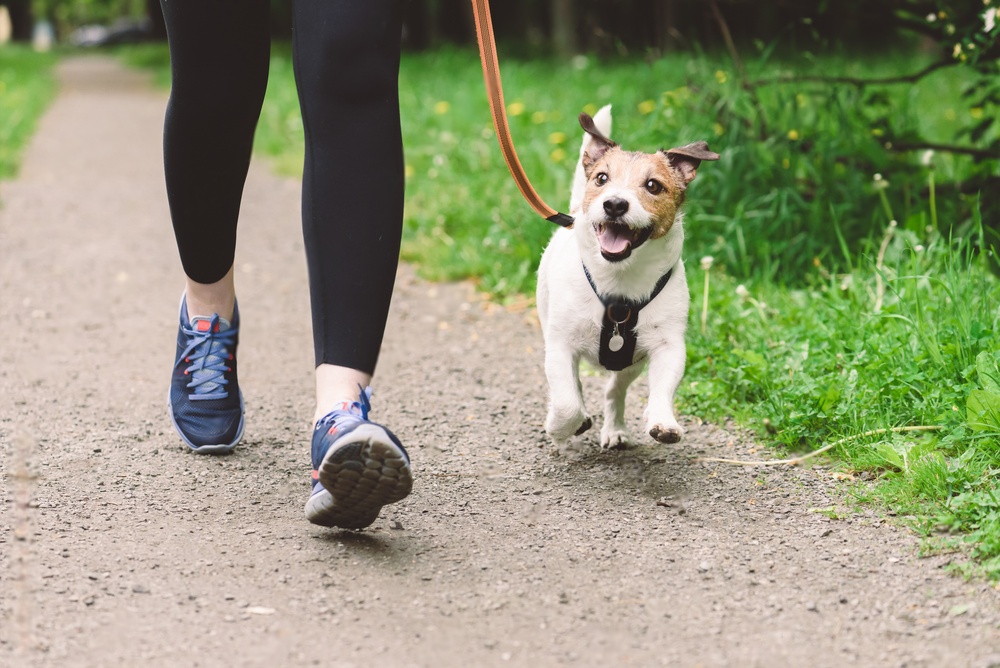As a responsible pet owner, it is important to know that the ideal daily walking schedule for your furry friends is more than just a routine—it’s a crucial part of their pet’s health and happiness.
The simple act of walking not only provides physical exercise but also mental stimulation and opportunities for socialization. But how often should you be lacing up your shoes and grabbing the leash?
In this blog post, we have provided a vet-approved answer to this question “How often should you walk your dog daily?”. We will also discuss factors that influence how often your dog should be walked daily.
Without further ado, let’s begin!
How Often Should You Walk Your Dog Daily and the Durations
The frequency and length of dog walks can vary widely based on factors such as age, breed, and energy level.
Generally, it’s recommended to walk your dog at least once a day, but more active breeds may require more frequent outings. A good baseline is a 20-minute walk daily, though young, energetic dogs might need upwards of 40 minutes of exercise to burn off their excess energy.
What are the Benefits of Walking a Dog – How Does it Improve a Dog’s Behavior?

Walking your dog regularly is not just a good way to keep them physically fit; it has profound effects on their behavior and overall well-being.
Below are the benefits of walking your dog regularly:
It Reduces Anxiety and Stress
Regular walks can significantly lower a dog’s anxiety and stress levels. The combination of physical activity and mental stimulation during walks helps release pent-up energy, reducing tendencies towards anxiety-driven behaviors such as excessive barking or destruction.
It Improves Socialization
Walks are a fantastic opportunity for dogs to encounter various people, animals, and environments. This exposure is critical for developing a well-rounded, socially confident dog. Dogs that are regularly walked are less likely to exhibit fear or aggression towards new experiences.
It Stimulates the Mind
The sensory stimulation dogs receive from the smells, sounds, and signs during walks is invaluable. This mental engagement is just as important as physical exercise, helping to keep their mind sharp and focused. Dogs that enjoy regular walks often show improved alertness and eagerness to learn new things.
It Encourages Positive Behavior
Regular walks can help channel a dog’s energy into constructive activities, reducing the likelihood of them engaging in unwanted behaviors at home. A well-exercised dog is typically more relaxed and content, leading to fewer instances of behaviors like chewing, digging, or scratching.
It Strengthens the Bond between you and your Dog
The time spent together on walks strengthens the bond between you and your dog. This shared experience builds trust and mutual respect, enhancing your relationship. A strong bond with your dog encourages obedience and a desire to please, which are the foundations of good behavior.
It Provides Routine
Dogs thrive on routine, and regular walks help establish a healthy, predictable schedule. This routine can make your dog feel more secure and balanced, knowing they have structured times for activities. A consistent walking schedule can reduce anxiety in dogs, as they know when to expect their next adventure outdoors.
Factors That Determine How Often a Dog Should Be Walked
When deciding the best walking schedule for your dog, several factors come into play. Each of these elements can help tailor a routine that fits both your lifestyle and your dog’s needs, ensuring they remain healthy, happy, and well-adjusted.
Dog Breed

The breed of your dog significantly influences their exercise requirements. Active breeds like Collies and Australian Shepherds need more physical activity compared to breeds designed for companionship, such as Yorkshire Terriers and Papillons. However, individual preferences can vary even within the same breed, with some dogs showing a natural inclination toward athleticism, while others may prefer a more sedentary lifestyle.
Special attention is needed for brachycephalic breeds, like Pugs and Boxers, due to their susceptibility to overheating and potential for heatstroke.
Top 10 Energetic Dogs That Need Regular Walks
Some dog breeds are known for their high energy levels, and they require regular, vigorous walks to stay content and healthy. Some of them include:
- Border Collie
- Australian Shepherd
- Labrador Retriever
- Golden Retriever
- Siberian Husky
- Jack Russell Terrier
- Dalmatian
- Boxer
- Weimaraner
- English Springer Spaniel
Age
A dog’s age is a primary factor in determining its walking needs. Younger dogs usually have more energy and require more exercise to stay content and healthy.
As dogs grow into their middle-aged and senior years, their energy levels and physical capabilities may decrease, potentially limited by conditions such as arthritis, muscle atrophy, or diseases like hypothyroidism or diabetes.
While walking your dog, it is important to observe his response to exercise. If he seems happy and active, you may adjust their activity level but if he seems tired and uninterested, you may reduce the activity or even stop the walk or exercise for that day to prevent overexertion.
Your Dog’s Exercise Tolerance
Understanding and respecting your dog’s exercise tolerance is key. Most dogs can handle a daily walk of 20–30 minutes if they’re in good health.
Dogs with excellent physical health may enjoy longer activities, such as hikes, while those who are overweight or have health issues might struggle with shorter walks. Observing your dog’s behavior during and after walks can provide insights into their fitness level and whether the exercise is too much for them.
Your Schedule

Your schedule plays a significant role in determining how often you can walk your dog. While the ideal is to provide your pet with at least 140 minutes of exercise per week, busy lives and work demands can make this challenging.
If your schedule limits your ability to provide daily walks, consider shorter walks, playtime in the yard, or hiring a dog walker to ensure your dog still gets the necessary activity
Consistency and Routine
Dogs thrive on consistency and routine, which helps them feel secure and manage their expectations. Establishing regular walk times can be comforting for your dog, allowing them to better regulate their emotions and look forward to their next outdoor adventure
Final Thought
Walking your dog is about more than just physical exercise; it’s a vital component of their overall care. The right frequency and duration of walks can significantly impact your dog’s physical health, behavior, and emotional well-being.
By tailoring your walking routine to your dog’s specific needs, you create a fulfilling and joyful experience for both of you. Remember, a well-walked dog is a happy dog.
Frequently Asked Questions
How much exercise do dogs need daily?
Dogs generally need about 20 minutes to 1 hour of exercise daily, depending on their breed, age, and health status.
What are the reasons why dogs need walks?
Walks provide essential physical exercise, mental stimulation, and opportunities for socialization, and help prevent boredom and destructive behaviors.
Is it okay not to walk my dog every day?
While daily walks are beneficial, some dogs may still be content with less frequent walks if they have other forms of exercise and mental stimulation. However, strive for regular activity to maintain their health and happiness.







Leave a comment